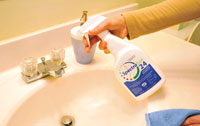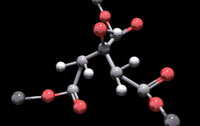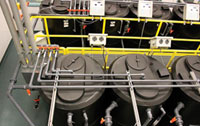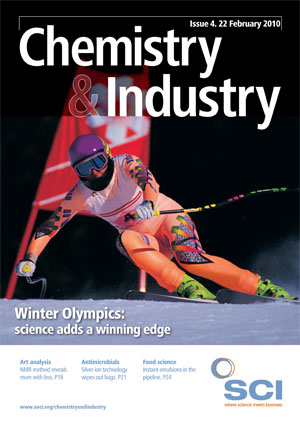A stabilised form of ionic silver, the antimicrobial active SDC has opened up a host of applications for this tried and tested silver technology, writes Michael Krall
Hippocrates, the father of modern medicine, wrote that silver had beneficial healing and antidisease properties, and ancient cultures stored food, water and other liquids in silver vessels to prevent spoilage. Since then, several industries have embraced silver as a natural and effective antimicrobial solution, with silver technologies now prevalent in food processing and packaging materials, water treatment equipment, textiles, construction products and heating, ventilating and air conditioning (HVAC) systems.
Stabilised ionic silver

When approved by the US Environmental Protection Agency (EPA) in 2003, in its hard surface formulation Axen-30, SDC became the first new disinfectant active to be registered by the EPA in more than 30 years. Axen-30 was claimed to kill the disease-causing microbes Staphylococcus, Pseudomonas and Salmonella in just 30 seconds – 20 times faster than the then leading competitor. Rated as a category IV antimicrobial in terms of toxicity, Axen-30 was also judged to be safer than most other leading brands at that time which were mainly rated as category II products.
Since then, however, SDC has moved on a long way. As well as its activity against bacteria, SDC-based disinfectants are now known to have antiviral, and antifungal properties and are also active against the notorious ‘superbugs’, carrying a US Environment Protection Agency (EPA) -registered two-minute kill claims against MRSA (Methicillin-resistant Staphylococcus aureus), CA-MRSA, PVL-MRSA and VRE (Vancomycin resistant Enterococcus faecium).
In May 2009, the EPA included SDCbased disinfectants in its published a list of antimicrobial products that are effective against the 2009 H1N1 swine flu strain and also meet the US Centers for Disease Control (CDC) recommendations for infection control against the swine flu virus. PURE’s SDC disinfectants have been registered by EPA for use on children’s toys, cribs, high chairs and other sensitive areas in the home as well as for use on hard surfaces in environments including schools, hospitals and offices, and are odourless, colourless, noncorrosive, non-flammable and compatible with other disinfecting and cleaning chemicals.
In August 2009, PURE announced that it has EPA registration for its SDC-based sanitiser, sold under the trade name Axen-50, for sanitisation of food contact surfaces and equipment in environments including farms, food processing plants, schools, hospitals and other institutions, restaurants and homes.

Foodborne illness creates not only health but also confidence issues for consumers. Food recalls can have a significantly negative economic impact on businesses. For example, salmonellosis is estimated by the CDC to cost more than $1bn in medical costs and lost wages annually in the US.
The EPA’s registration of Axen-50 as a food contact sanitiser cleared a big hurdle for PURE. Now that we have established a food contact tolerance of 50ppm of silver, this registration provides two roads to market for SDC-based food contact surface sanitisers via the EPA. We plan to add the extensive broadspectrum antimicrobial claims from our existing disinfectant registration to the registration of the new food contact sanitiser, and also through the EPA, we expect to amend our disinfectant product registration claims to add the new food contact sanitisation claims. The EPA regulatory work will include state registrations by distributors and is expected to take at least six months.
Sanitisers

SDC formulates well with other compounds, acting as both a preservative and biocide that harnesses the antimicrobial properties of silver. The molecule is generated through a proprietary process (see Box) and combines with one or more organic acids to form a stable, efficacious new antimicrobial active or preservative. While SDC is highly toxic to bacteria, fungi and viruses it is non-toxic to humans and animals.
Ionic silver’s multiple modes of action are believed to be responsible for its quick and broad-spectrum efficacy. SDC plays the roles of both hunter and prey, using acids to attract and ionised silver to destroy bacteria and viruses.
SDC is a ‘Trojan Horse’ food source. Bacteria recognise the complex as a food source and move toward it via positive chemotaxis. This attack allows SDC to easily enter the organism, whereupon it causes irreversible damage to DNA and protein structure and function. Critical metabolic and reproduction functions halt and the organism dies.
Additionally, SDC is attracted to sulfurcontaining thiol groups common to proteins in the organism’s outer membrane. The complex destroys protein structure and function, causing lysis of the membrane and death of the organism. This dual action makes SDC highly and quickly effective against a broad spectrum of microbes. After microbial threats have been eliminated, surplus SDC provides residual protection against microorganisms. This provides prolonged protection up to 24 hours, contrary to the ‘here and now’ methods of traditional products.
Overall, creating a stabilised ionic silver formulation opens the door for its use in a wide array of products and treatmentsincluding personal care, food and water, textiles, agriculture and pharmaceuticals as well as consumer, commercial and industrial sanitisation and disinfection. As a proprietary ‘disruptive technology’, SDC is the first antimicrobial to emerge from its development platform as a biocide with broad spectrum activity and residual protection.
PURE Bioscience, which developed, patented and supplies SDC, has partnered with several companies to develop, market and sell the final products, including an agreement with specialty chemical manufacturer Ciba, now acquired by BASF, to market SDC in a variety of personal care products as a non-toxic, green biocide formulation. The company also has distribution agreements with several US companies to market SDC-based products, particularly as a hard surface disinfectant and as disinfectant wipes. In addition, SDC has application in agriculture, as it has shown ability to kill fungus on soya beans, and has been used to purify water in Africa. Meanwhile, PURE’s relationship with US pharmaceutical development firm FTA Therapeutics and the Cleveland Clinic is expected to yield several pharmaceutical products and medical devices for wound care and other dermatological applications.
Future applications also include a deodorant and antimicrobial active for personal care products, a preservative for personal care products and in wound care, pharmaceuticals, agriculture, industrial and commercial biocides. Human and agricultural trials for some of these newer applications are in progress and data should be available in the first half of 2010.
Beiersdorf, the German manufacturer of Nivea cosmetics, recently began using SDC as the active ingredient in a number of deodorants, called Silver Protect, available for sale in most of Europe, as well as parts of Asia.
The specialty chemical industry will face continued pressure from regulatory bodies as well as from consumers, who are increasingly concerned about the toxic properties of many of today’s biocides. The investment opportunity for technologies that satisfy this niche will be substantial. The scientific community’s interest in silver as an antimicrobial agent has been piqued due to its good safety profile and ability to formulate well with other compounds, which will help meet the growing demand for ‘greener’ biocides across multiple markets.
Michael Krall is founder and ceo of PURE Bioscience, based in El Cajon, California, US.





